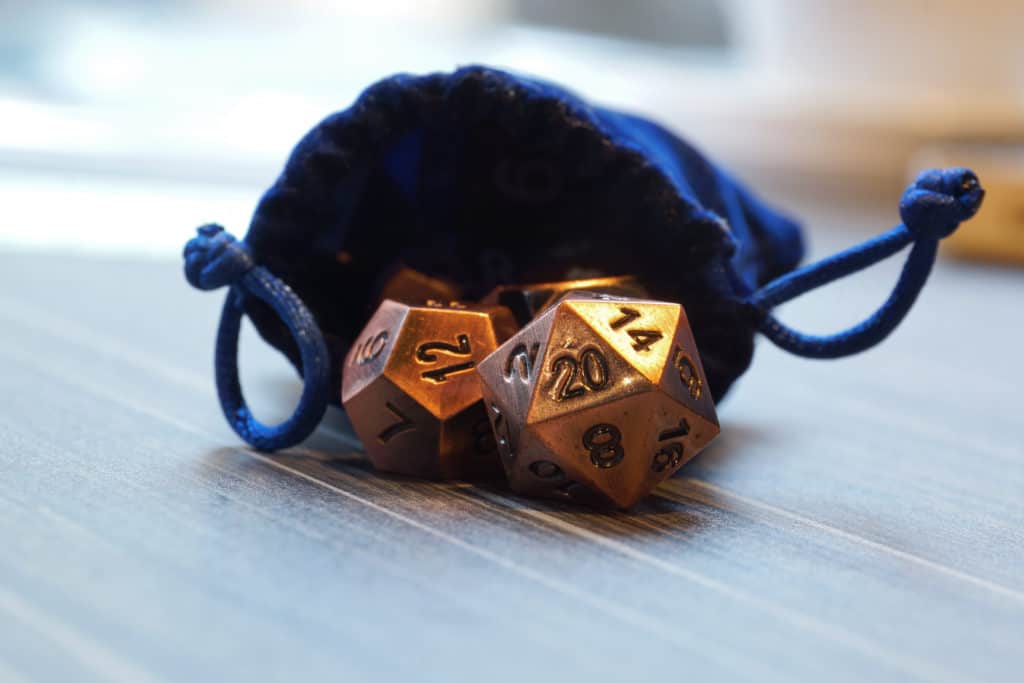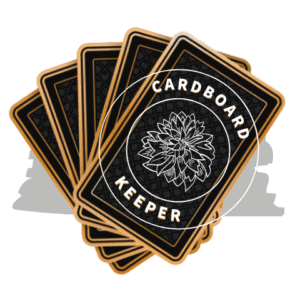Magic the Gathering is one of the oldest trading card games out there. Since they just recently reached their 25th anniversary, this card game has a lot of intricate details. So what do you need to play and do you need dice?
As a whole, Magic the Gathering uses dice. Dice are used to keep track of life totals and certain sets use dice for card mechanics. The set Unstable requires six-sided dice rolling for many of its cards and the set Adventures in the Forgotten Realms uses twenty-sided dice.
There are a lot of details and options in this game, but it’s a good idea to keep a set of dice on hand. Below we’ll explore some of the common dice uses in MTG and some specific sets that require dice.
How Are Dice Used in Magic the Gathering?
Magic the Gathering (MTG) primarily uses dice to keep track of details that get too taxing to track in other ways. This primarily means they are used to measure large quantities of tokens, counters, and of course health.
Life Totals
Each MTG prerelease pack and Fat pack come with a spindown twenty-sided set die.
A spindown die is a 20 sided die whose sides numerically rotate from 20 to 1 rather than having numbers that add up to 21 on each side of the die. This is for convenience so that you can more easily locate a number when using the die to track life totals.
In Magic, you primarily have 20 life as a starting total. As such you measure this with a spindown die (which in this case, would be a die called a D20) by setting it to 20 and lowering the face of the die whenever you take damage.
Counters and Tokens
MTG has a lot of things to keep track of; dice are often used to assist this process.
The primary use for this are +1/+1 counters on creatures. Certain creatures or spells will provide a single creature with a permanent buff called +1/+1 counters. These increase the strength and toughness of your creature. Because these counters can continually stack on a creature, it is easier to track the number of counters on a creature with a die rather than with individual counter tokens.
Similarly, there are cards that summon tokens. These tokens can be either creatures or artifacts.
Regardless some spells will summon a multitude of the same creature/artifact and it is better to have a single token with a die representing the total quantity of tokens available to a player than represent it by filling your board with multiple versions of the same token, especially as some combinations of cards can create excessive quantities of tokens, even infinite tokens!
Keeping Track of Mana
There are many cards and combinations of cards in MTG that generate tons of mana outside your mana cards you tap and untap each turn. To accurately keep track of any extra mana, many players use different colored dice to track that mana and to distinguish the color of mana in your mana pool.
In addition to the mundane uses of organization that dice are used for, there are in-game mechanical uses for dice as well.
Card Mechanics Using Dice

Since dice have been more integrated with D&D for organizational purposes it has become more common for dice to appear on card mechanics.
This was demonstrated originally in the silver-bordered, (which means the set is unofficial) Unstable set and then became a feature again recently with the release of the Dungeons and Dragons-themed set called Adventures in the Forgotten Realms.
Unstable
The Silver bordered sets (or the “Un”-sets,” as they are sometimes referred to) are designed to be more comical than most magic sets as well as push the boundaries of what magic does.
Unstable used a lot of dice rolling as a feature within the set. This added an element of randomness that served as a reflection of the wildness of the mad science that the set was representing.
This set primarily used D6s or six-sided dies to represent these effects that are triggered above a certain threshold.
Dice rolling had been tested several times previously in magic for various sets, but was seen as too chaotic so it was relegated to the more chaotic “Un-set.” Specifically, it was included due to the designers’ focus on relegating the power of the dice by color to create a form of control within the colors of the cards.
Since the release of Unstable, the dice mechanic was introduced to a black-bordered set in Adventures in the Forgotten Realms.
Adventures in the Forgotten Realms
Adventures in the Forgotten Realms came out in July 2021 and served as a replacement to the Core Set of that year.
It served as an official cross-over between Dungeons and Dragons and Magic the Gathering. Both games are owned by Wizards of the Coast, and Magic the Gathering is inspired by Dungeons and Dragons, so it made sense to release a set like this! As a means of paying tribute to the game, several cards have a feature that lets you roll the classic D&D D20 or twenty-sided die for certain effects.
These effects, much like Unstable, were largely relegated to two forms of activation. Enter the battlefield (ETB triggers) and mana cost triggered abilities. The majority of these cards paid tribute to the classic D&D concept of critical hitting on a natural 20 by having tables that generally looked like:
| 1-9 | Standard Ability |
| 10-19 | Increased Ability |
| 20 | Potently Increased Ability |
Unlike Unstable, where many of the effects would only trigger on certain die rolls, the Adventures in the Forgotten Realms set seemed to use dice as an extra effect. So playing the card has a decent reward regardless of what you roll with the value increasing the better that you roll.
Notable Dice Rolling Cards
As Luck Would Have it
This enchantment lets you win the game if you have rolled a total of 100 or more since it has been on the battlefield.
This is from Unstable so it is a silver-bordered card but if you are able to play silver-bordered cards or are playing in a full silver-bordered game, this can be a fun alternate win condition.
Barbarian Class
The Barbarian Class enchantment reflects what the Barbarian class does in D&D by granting you an advantage on die rolls in the same way that a recklessly striking barbarian would gain an advantage in D&D.
Advantage means you roll two dice and take the higher number. This is essentially a mainstay in any D20 die rolling decks and is a welcome addition to the wildness of Red as a color in Magic.
Critical Hit
This is one of the most favored cards in the Adventures in the Forgotten Realms set.
This card lets you return itself from your graveyard every time that you roll a natural 20. Add that to the fact that it gives your creature a double strike just like how you would double your damage on a roll of a natural 20 in D&D and this card is not only a great card but so well designed to reflect one of the greatest known mechanics of D&D.
Pixie Guide
Similar to the ability that the Barbarian Class provides but only a one-time use, Pixie Guide can provide advantage on the next roll made. This is once again a reflection of Fifth Edition D&Ds advantage mechanic and also demonstrates Blue’s aptitude for control.
Vrondiss, Rage of Ancients
Vrondiss is the only commander of the Adventures in the Forgotten Realms commander boxes that actually cares about rolling dice. It’s a subtle touch but one that reflects the chaos of the Red and Green Color combo.
Conclusion?
Keep dice on hand! At the very least they’re handy for using as a life tracker and depending on your deck build, there is a fairly good chance you’ll be implementing counters, especially if you are using green or white decks. Long story short, you can’t go wrong having a few D20 dice on hand when you’re playing Magic the Gathering!
